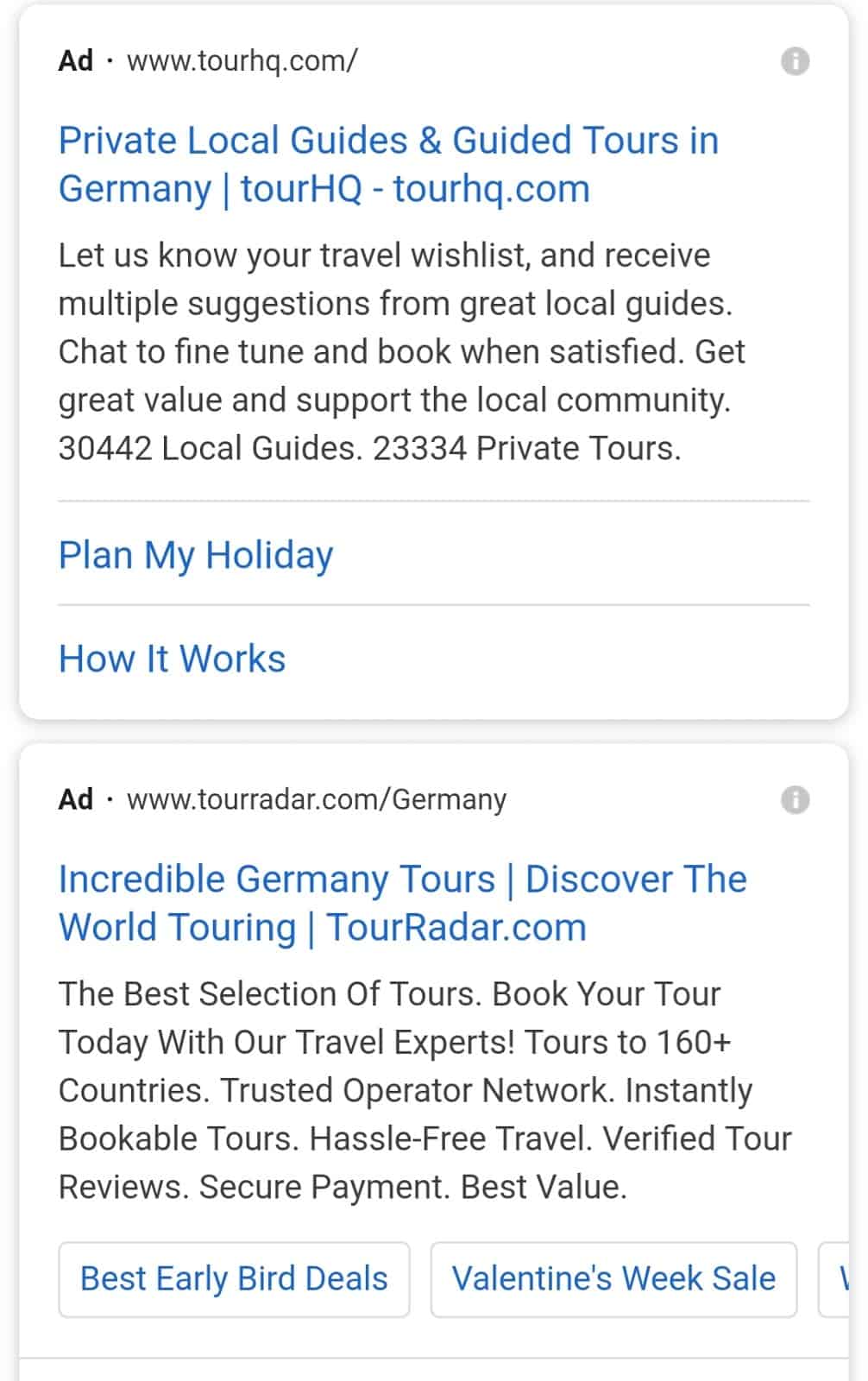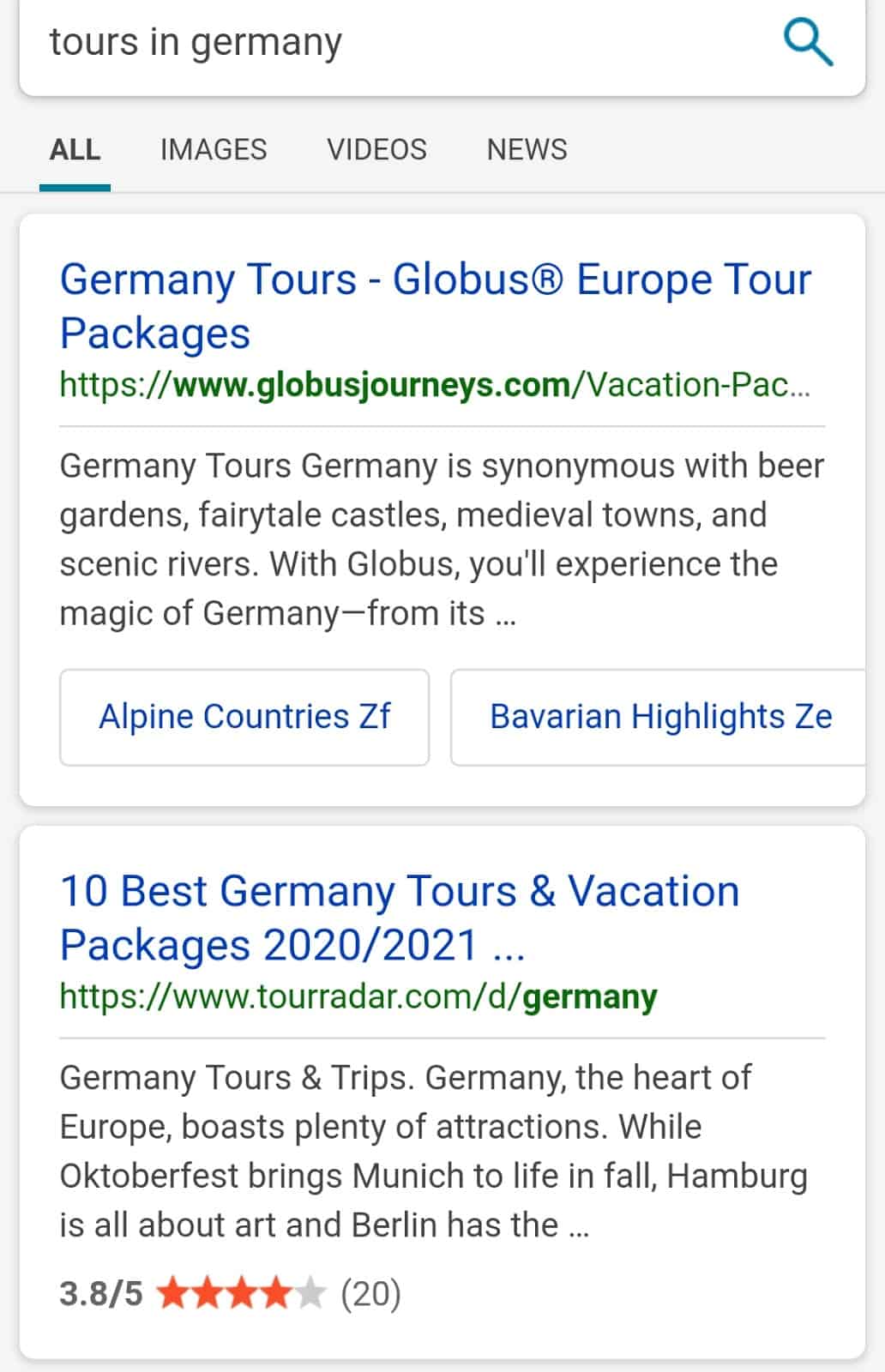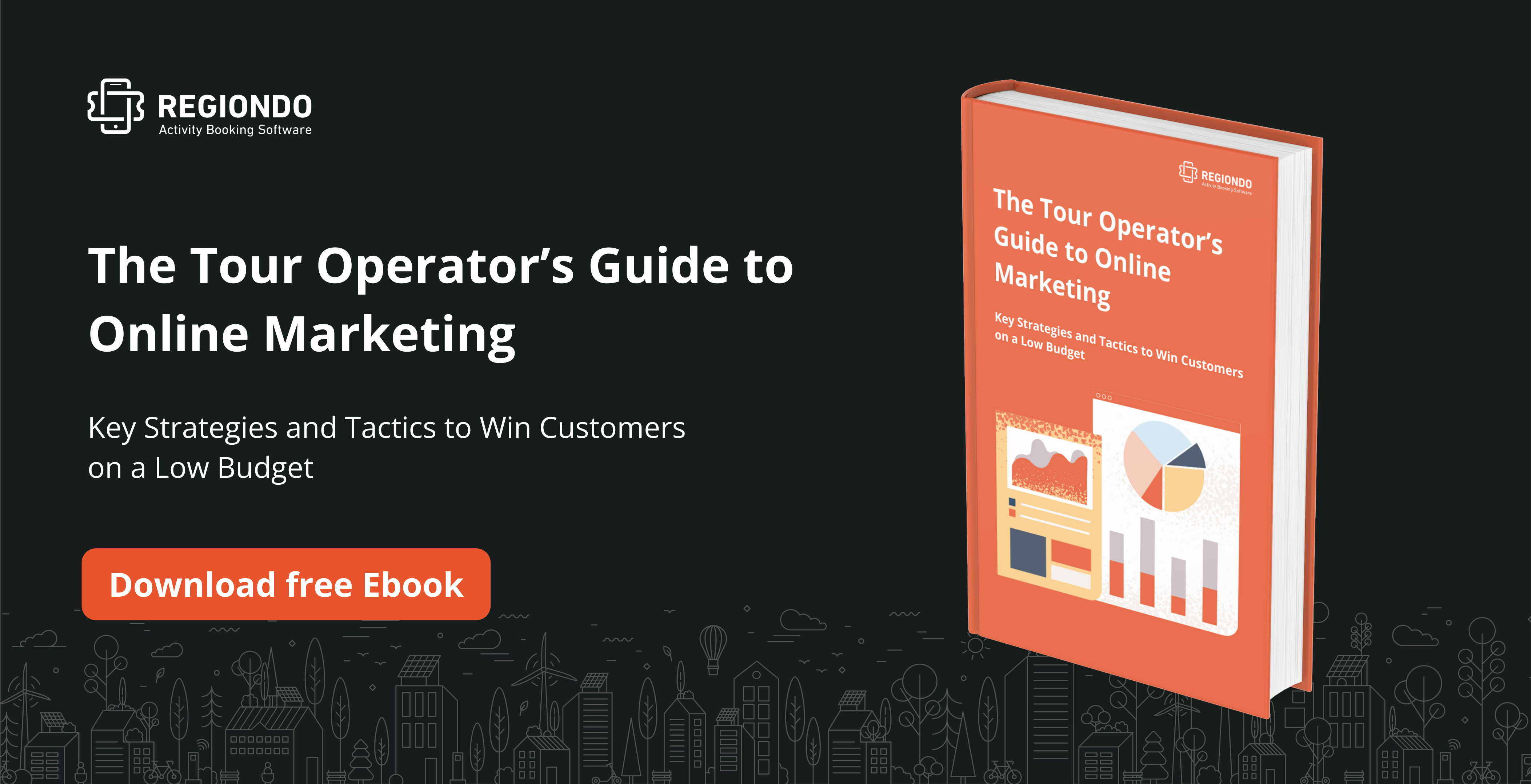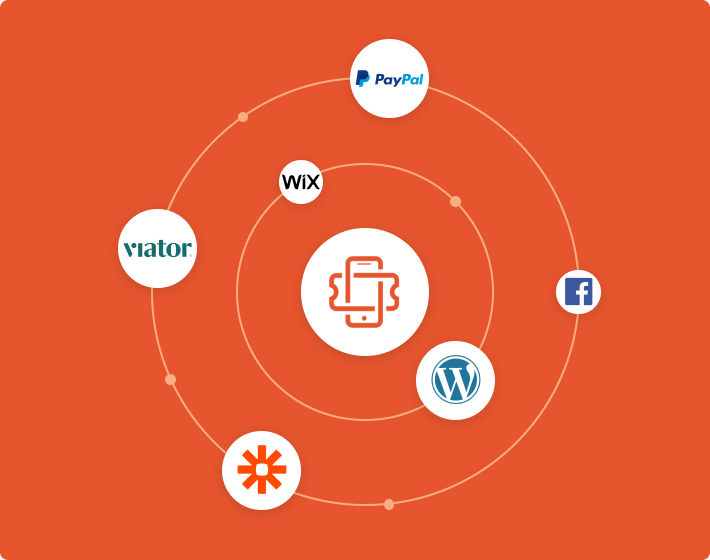The tourism industry is massive (valued at $8.27 trillion in 2017) and it is expected to grow at a higher rate in coming years. In order to participate in this growth as a tour operator, you need to join the “modern” tour advertising school of thought.
That’s right. Your customers are no longer in the 90s but 2021. You need to meet them where they are today: online. That means on search engines, social media, and travel sites like TripAdvisor.
This article will go over how to find your customers online and how to advertise your tours to them effectively; using channels like Google, Facebook and TripAdvisor, among others.
Let’s first start by breaking up the relevant online advertising channels by medium. We will break them up into three categories: Search Engine Marketing, Social Media Marketing, and Metasearch Engine marketing.
Let’s get to it.
Search Engine Marketing (SEM)
Google Ads (formerly AdWords)
There’s no question that Google is the king of search engines. With over 63,000 searches per second every day, advertisers have a great opportunity to get their share of visibility in Google’s massive network. Yes, that means you as a tour and activity operator can get your brand out there in front of thousands of eyes each month.
Google Ads gives you the opportunity to display text ads on Google’s search results page as well as their network of search partners. The best way to make the most of this opportunity is to first understand your specific business model inside out.
Here’s how you can understand that, and start creating effective ads on Google Ads:
1. Set Your Goal
Your goal is to first and foremost boost bookings for your tour and activity business, right? Then you need to note that and clearly define it.
Your goal could also be to get more referrals or to increase awareness. Whatever the goal, define it.
2. Figure out a way to measure it
Once you’ve defined your advertising goals, you need to ensure that you’re able to measure them. Otherwise, your marketing efforts would be fruitless.
For example, if your goal is to drive more bookings, you need to ensure that you can measure that goal by using an activity booking software, like Regiondo, that enables Google Ads tracking. You should also add Google Ads conversion tracking codes to thank you pages on your website.
If your goal is to build awareness, you should track that by looking at the volume of users who visit your site, visit specific pages, or an increase in email subscribers during your Google Ads campaign period. You can pull up this information in Google Analytics.
So now, you’ve defined your goals and found a way to measure progress towards that goal. You should comfortably be able to state your goal and measurement of that goal in a simple sentence. For example, it could be “Increase bookings and measure that goal with Google Ads conversions.”
3. Set Your Target Audience
You already know who your ideal customers are, right? If not, check out this guide on how to define your ideal audience. Before you start running campaigns on Google Ads, you should jot down everything you know about your ideal customer so you can accurately target your ads and minimize unnecessary costs.
Ask yourself the following questions:
- Who is most likely to book my tours and activities? Men or women?
- Which age range books more of my tours and activities?
- Has that audience visited my website lately? (You can find out specific demographic data from Google Analytics.)
- Which tours and activities are most likely to be booked by that demographic?
4. Keyword Research
Now that you know your goals; how to measure those goals, and properly defined your target audience; you can now move onto keyword research. Keywords are the words or phrases your audience uses to find your offerings.
An easy way for you to figure this out is to answer the following questions:
- Will your audience easily find you with branded keywords, i.e., your business name or the names of your tours and activities?
- Which terms are your target audience most likely to use to find tours and activities like yours? Perhaps you could ask your customers how they found you online to get more insight into this.
- Which location keywords can you pair with your main keywords to create location-specific keywords?
- Which broad search terms could your audience use to find you? If for example, it’s “activities around me” (a very broad search term), you could pair it with your location for more accurate targeting.
- Which keywords are your competitors bidding on? (You can find this out by googling some keywords and checking which of your competitors show up in ads for those keywords. An alternative is to use SEMrush to easily obtain that information.)
Once you’ve identified some keywords, you need to filter through and find the best ones by relevance, volume, competition, and cost. You can use SEMrush to do that.
5. Create Your Campaign
How you structure your campaign largely depends on how you answered the questions above. The Google Ads structure isn’t much different from a Facebook Ad in that the highest level is the campaign, where you decide the campaign type, bidding strategy, and campaign budget.
The next level is the Ad Group where you set your targeting, keywords, and cost per click rate.
The last level is where you create the ads and messaging.
Keep the following things in mind when you set up a campaign:
- If you’re bidding on generic or branded keywords, keep them under a separate campaign.
- Break your keywords into categories so you can create Ad Groups for each category. For example, you would want day-to-day consumer bookings under one Ad Group and corporate bookings under another since those two categories require different target audiences.
6. Budget
Each Google Ads campaign requires a daily spend – the amount you want to spend daily. We recommend you set the daily budget based on a multiple of the profit you earn per customer. For example, if the tour you’re advertising goes for $125 (per customer) and your profit is $100 (per customer), you could set your daily budget at $100.
The logic behind this is that if you spend $100 per day on Google Ads and get one customer per day from those ads, you’d break even. If you don’t get at least one new customer per day, you’d lose money meaning Google Ads may not be the best way for you to market your business.
However, you can still choose to set a weekly target of let’s say $200. Make two new customers every week and you’d break even.
7. Create Ads
Before we dive into the next part, let’s talk about why picking the right keywords, URL and creating the right ads can make Google Ads really work for your business.
When a user searches for a tour online, whether it is a generic or specific search term, Google will show them the most relevant ad that contains the information the user is looking for. That greatly increases the chance of a booking, right?
However, in order for Google to serve up the most relevant ad, they rely on the details you submit about your tour and activities. See what we are getting at?
You need to provide thorough and high-quality information about the tours and activities you’re offering so that Google can recognize your offerings as relevant to searches.
Alright, next: creating ads. There are quite a few sections in this area to fill out, including:
- Final URL: The URL the ad will direct users to. Could be your website or a landing page. The URL needs to be clean as it will show up in your ad.
- Headlines: There are 3 fields to populate headlines for an ad. You can use all three or just one (Google adds a “|” character between the headlines)
- Display path: This is where you input the display URL for an ad.
- Descriptions: There are two fields for descriptions. These come below the display URL in the final ad copy. (Don’t worry, you’ll see a preview of your Ad as you populate in fields in Google Ads.) The first description always shows but the second may not due to Google’s character limit of the character constraints of their partners.
Here is how text ads look on the desktop. These are from results that came up when we did a generic search of “tours in Germany”.

Here’s how they look on mobile:

Bing Ads
Now, Bing is a smaller search engine than Google, but its market share is growing faster than Google’s. It is the second biggest search engine in the United States, meaning that you’re missing out on a big opportunity if you ditch Bing for Google Ads.
Additionally, there is less competition on Bing Ads and a lower cost per click rate. Translation: you’ll get a higher ad position and a better click-through-rate on Bing Ads. It is relatively cost-effective for tour and activity providers (check out their target audiences – 35 percent are planning domestic travel while 14 percent are planning international travel).
If you have already created a Google Ads campaign, you can copy and paste the campaign into Bing Ads in a single click. You’ll just need to tweak a few campaign settings like location targeting, language, negative keywords, automated rules, and CPC (CPA is not available in Bing Ads).
Yup, Bing Ads follows a similar format to Google Ads so we won’t bore you by getting into it.
Here is a preview of desktop and mobile ads for the search term “tours in Germany”.

Desktop version

Mobile version
As you can see, there aren’t any ad results for “tours in Germany”. There’s a big untapped market there that you could take advantage of.
So, Bing or Google Ads?
Yes, Google Ads is the market leader in search but Bing Ads has a lot to offer you as a tour and activity provider.
We recommend using both as they are equally good platforms to market your offerings on. Plus, they are also very similar (once you get a hang of Google Ads, you’d be able to transition to Bing Ads quite easily) so there is no real learning curve when switching between the two.
Use both to reach untapped audiences and get the most bang for your advertising bucks.
Facebook Travel Ads
Did you know that social media advertising accounted for 30 percent of ad spend for travel marketers in 2018? That number has grown since then as Facebook and Instagram launched Facebook Travel Ads (formerly Facebook Dynamic Ads) to address the specific needs of travel marketers.
Additionally, travelers spend five times more time on Facebook than travel apps, sites, and searches; and 76 percent of Americans use Facebook weekly to spotlight their travel experiences, and ask their friends for travel recommendations. Furthermore, 96 percent of travelers use Instagram to get travel inspiration.
That means that you’re missing out on a massive opportunity if you’re not advertising your tours via Facebook Travel Ads.
How to Create Effective Facebook Travel Ads
Facebook Travel Ads are different from standard Facebook Ads in that they are designed specifically to help travel companies reach audiences that are most likely to book their offerings.
If you want to run Facebook Travel Ads, you’ll need to set up a Facebook pixel on your site and then upload your trip inventory with all the details to Facebook. (You can actually integrate Facebook pixels in Regiondo.) You can then create a template with ad creatives like images and information you’d like customers to know.
The good thing is that your ads only need to be set up once; the campaign runs at the appropriate time based on factors like your tour inventory and online/offline behaviors of potential customers.
Let’s now move on to factors that impact Facebook Ads and how to get the most out of Facebook Ads.
It’s All About Targeting
As we mentioned earlier when we discussed SEM ads, it is important to have a very clear and specific idea of who you are marketing to. Who is your target audience? What do they like? Where do they live? What do they do professionally? How old are they? What are their hobbies?
It’s important to note that Facebook users have different intent than they do on other channels: they may not be looking to purchase anything, unlike someone who searches for a tour in Google.
For that reason, it’s important to accurately target your Facebook ads to the right audience who are most likely to be interested in your tours and activities. So as a tour and activity company, you’ll want to target people who are interested in travel, in your destination and the type of tour you offer. You’ll also want to target those who have taken trips before, are currently on a trip, or are planning to take one.
Let’s dive into more specific targeting tips for effective Facebook advertising.
1. Target Tourists
The good thing about Facebook is that you can use various demographic, behavioral, and interest-based targeting criteria to hone in on your ideal customers. The most relevant of these targeting options is arguably location.
Facebook offers four different location targeting options. Of those, “People traveling in this location” would be the best option for tour and activity providers. With a good enough budget, you’d be able to reach practically every Facebook user traveling in your city for a few days.
2. Target Families
If you offer “family-friendly” tours, you can easily target them in the Behaviors > Travel > Family Vacations section. To narrow it down further, you can choose to advertise to “Parents with early school-age children (06-08 years)” in the demographics section.
3. Welcome New Visitors to Your City
How about putting out a welcome offer to new visitors? Sounds neat, huh? Ads that offer something for free, be it tips or a free tour manual, perform quite well with a lot of engagement.
4. Target Based on Interests
Now, this is a great idea if you offer specific travel interests. For example, if you specialize in scuba diving activities or adventure travel, you can target those who are traveling to your destination and are interested in scuba diving or adventure travel. You can add as many interests that are pertinent to your company in order to create a highly specific and converting audience.
Remember, you don’t have to stick to a single way of using Facebook Ads. We just provided effective tips you could use but recommend that you try out different strategies to figure out what works best for you. So go ahead and experiment with Facebook Travel Ads or even regular ads. You can boost posts, create new campaigns, target different audiences (even your email list!), and see how it goes.
Tour and activity providers have a massive opportunity this year to make use of the largest social media network in the world to grow their businesses. It’s an untapped market that you can easily tap into (using the tips and strategies above) and make substantial sales.
Check out our complete guide to tour advertising with Facebook.
Pinterest boasts 332 million active monthly users who are looking for new ideas and inspiration, with the focus of the platform being beautiful imagery. How does it pertain to your business though?
Well, 68 percent of Pinterest users create Boards for places they’d like to visit and even hotels they would like to stay in. What does that mean for you?
A great opportunity to show off your offerings, which could translate into significant sales if you play your cards right. More accurately, if you employ the right advertising strategy for Pinterest.
(If you’re unfamiliar with Pinterest, check out this article.)
Pinterest Ads are relatively easy to execute (in comparison to Google, Bing, and Facebook Ads). Once you create a Pinterest page for your business, you can create several posts (pins) that highlight your tour or activity.
Remember that it’s a visual platform so make sure the photos you post are visually appealing. Once users see your posts, they can save them to their own board or head to your website.
Now, to make your pins more visible, you can promote them via Promoted Pins. Promoted Pins essentially make it easier for users to quickly and easily find you among thousands of Boards.
Pinterest Ads are relatively easy to execute, please refer to Pinterest’s various Ad formats guide to see your tour advertising options.
YouTube Ads
Oh yes, YouTube Ads. Travel marketers fear them because video is time-consuming and expensive to produce. True, it is expensive, initially, but it pays off as video is the most interactive and engaging medium for all audience types.
The reason why many brands are now producing videos, hosting, and marketing them on YouTube is the sheer size and power of Youtube as a video social media network. Users watch over 1 billion hours of video daily…yes, 1 BILLION HOURS. Don’t you want your content to be among those views?
Lucky for you, we’ve already created a complete guide to YouTube marketing! Here it is.
Metasearch Engine Marketing
TripAdvisor Ads
Google is undeniably the king of search, but TripAdvisor is the “Google of travel.” Millions of travelers use the site monthly to search and book the best tours and activities in their travel destination. Not to mention that TripAdvisor houses over 700 million user-generated travel reviews.
The appealing thing about TripAdvisor is that it has an easy to use search engine for tours and activities, coupled with a good reputation. Tour and activity operators should take advantage of that by listing and advertising tours and activities to an active and engaged audience.
If you want to create organic search listings, your tour or activity will show up only when a user makes a relevant search query. However, with TripAdvisor Sponsored Placements, you can boost your listing to get higher quality traffic and visibility.
For more on TripAdvisor advertising, please refer to this recent post.
Measure, Measure, Measure!
When you start running ads, the first few weeks will primarily revolve around testing and optimizing. You should actually create several a/b tests to see which versions of your ads work best. Google Ads, Bing Ads, and Facebook Ads usually serve the best performing ads based on customer interests, so you should create as many ad variations as you can on those platforms.
You can also a/b test your targeting criteria. For example, you can target people who are about to travel as well as people who are already in your destination. Consider a/b testing different demographics and interests criteria to see which is most effective for your business.
The point is that you have to keep testing, measuring, and optimizing your ads in order to create really effective ones. This is not restricted to ads only, you should also test and tweak your landing pages to ensure that people are getting all the information they need to take the next step: booking with you.
Conclusion
Online advertising channels are great drivers of growth for any business in the travel industry, particularly tour and activity providers. However, your efforts will only bear fruit if you set up advertising campaigns based on your unique business goals and needs.
That is why it is so important to define your advertising goals, target audience, keyword strategy, and messaging before you create your first campaign.
This method will help you determine what you want to achieve and how to go about doing so. It will also help speed up the campaign creation process on all platforms.
This should be an ongoing process – as long as your advertising campaigns are active, you need to test, measure, and optimize.
Ready to dive in? Go for it! Online marketing is where it’s at in 2021.
You might also like:






